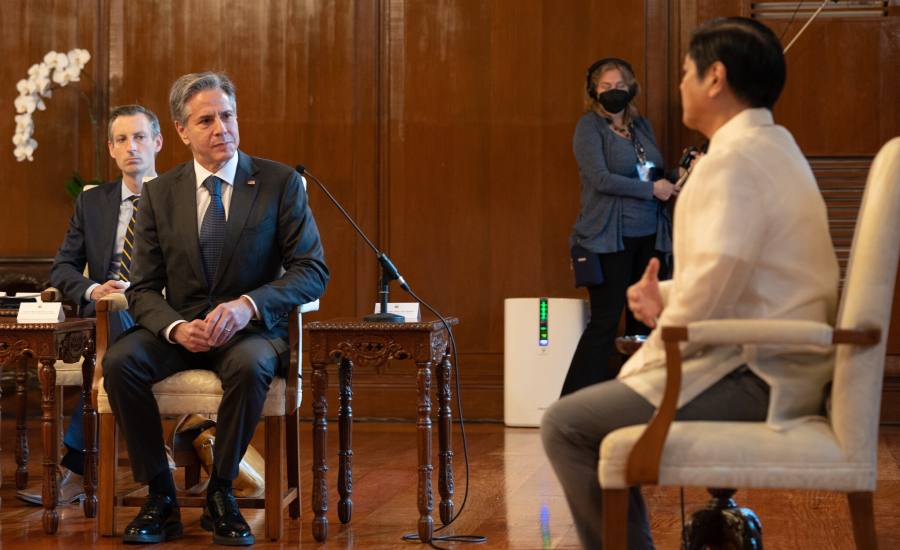Bangsamoro Peace and the U.S.-Philippines Alliance
Supporting the peace process in Mindanao will help shift Manila’s focus toward China.

Published by The Lawfare Institute
in Cooperation With

Editor’s Note: The United States has long worked with the Philippines on both counterterrorism and regional security issues such as the rising threat of China, but these issues often followed different tracks. Brian Harding and Haroro Ingram of the U.S. Institute of Peace argue that the new government in the Philippines and the Bangsamoro peace effort offer an opportunity for the United States to engage in peacemaking and, in so doing, cement U.S.-Philippines security cooperation.
Daniel Byman
***
The election in May of Ferdinand Marcos Jr. as the 17th president of the Philippines presents an opportunity to reset U.S.-Philippines relations after six rocky years while President Rodrigo Duterte held the office. After Marcos’s sweeping election victory, President Biden called to congratulate him and then dispatched a series of U.S. officials to Manila, including Secretary of State Antony Blinken. Any concerns that the Marcos family’s corruption and lingering legal issues in the United States would hold up relations have been pushed aside due to the enormous interests the United States has in a functioning U.S.-Philippines alliance.
During this honeymoon period, the Biden administration has prioritized reaffirming commitments under the Mutual Defense Treaty and Visiting Forces Agreement, which are fundamental to U.S.-Philippines defense cooperation and were often uncertain during Duterte’s tenure due to the former president’s hostility toward the United States and his attempts to deepen relations with Beijing. For the United States, the Marcos administration’s approach has been a breath of fresh air and has given U.S. officials hope that the United States will have reliable access to Philippines military facilities and that defense cooperation will increase in the coming years.
However, the United States should be clear-eyed about the spectrum of threats that Manila sees. While the Philippines harbors deep concerns about China in the South China Sea, it is internal threats to the country’s stability that remain Manila’s priority and the overwhelming focus of its armed forces, often to the frustration of its U.S. alliance partners. But the reality is that until the Philippines is at peace internally—most importantly in Mindanao—Manila will be unable to focus adequately on the issues at the top of Washington’s agenda.
Fortunately, a hopeful but fragile peace process is underway in Mindanao. The initiative has the greatest potential in living memory to deliver a lasting peace, which would eliminate key drivers of poverty, instability, and violent extremism—and, strategically, would remove a major domestic demand on the Philippines’ security forces. While the United States has been engaged in a counterterrorism mission in Mindanao for more than two decades, it has not dedicated time and resources to peace efforts, despite strong interest from local parties. It’s time it did. Supporting a sustainable peace in the country’s south is an opportunity for strengthening the U.S.-Philippines alliance that is almost entirely divorced from high-level politics but would do much to shift Manila’s priorities.
An Opportunity for Peace in the Bangsamoro
After decades of bloody conflict and cycles of failed peace efforts that spawned violent extremist breakaway groups in their aftermath, a peace deal between the Philippines government and the Moro Islamic Liberation Front (MILF) led to the establishment in 2019 of the Bangsamoro Autonomous Region in Muslim Mindanao (BARMM), often referred to locally as “the Bangsamoro.” The BARMM’s approximately 5 million citizens are overwhelmingly Muslim, and its establishment marks the most significant endeavor since the arrival of the Spanish over 400 years ago for an autonomous polity in the Philippines’ Muslim heartland. However, while the peace process holds promise, it remains fragile.
The Bangsamoro Transition Authority (BTA), a body jointly appointed in 2019 by the MILF and the central government, to govern the BARMM until its first elections in May 2022, was faced with an unenviable task: build a government from scratch on the archipelago’s most impoverished and conflict-ridden island, amidst the coronavirus pandemic. By March 2021, it was clear that the two-track peace process—in which the first track was working toward establishing the new, autonomous government and the second on demobilizing and disarming more than 40,000 MILF combatants—would not meet its objectives within the three-year transition period. With less than a year remaining in the original transition period, President Duterte signed into law a three-year extension of the transition period on October 28, 2021.
Despite now having until May 2025 to complete the transition and prepare for the BARMM’s first elections, the pressure on the BTA, as well as the national government and their international partners, has intensified. Expectations are high because the current moment represents a historic opportunity to finally achieve a sustainable peace in a region where wars have killed more than 100,000 Filipinos and traumatized generations. In the BARMM, impatience and high expectations among the population are putting pressure on local authorities. These pressures have created divisions within the MILF that threaten not only to fracture the group, and with it the MILF-dominated BTA, but also to fuel outbreaks of violence that could derail peace efforts.
More broadly, there remains a constant threat of conflict in the region. While clan wars (rido) regularly displace thousands of people each month, unravel the social fabric, and hamper economic development, it is grinding insurgencies by Islamic State-affiliated groups that locals cite as the greatest violent threat to the peace process.
All of the Islamic State’s affiliates in the Philippines operate in the BARMM. The most prominent of these is the Dawlah group in Lanao del Sur that was responsible for the 2017 Marawi Siege and is led by Abu Zacharia, who is reportedly the current emir of Islamic State East Asia (ISEA) province. Other affiliates include a faction of the Bangsamoro Islamic Freedom Fighters (BIFF) in Maguindanao and splinter groups in the Sulu archipelago that broke away from the Abu Sayyaf Group. By almost all accounts, these violent extremist groups are less active and more fragmented than they were when the Islamic State declared its East Asia province several years ago, thanks to constant operations by the Philippines military and local populations trying to give peace a chance. Nonetheless, these groups are eager to spoil the governance transition and are constantly seeking openings to gain legitimacy as the BTA faces challenges in its efforts to establish an administration that delivers gains for the population.
The U.S. Interests in Peace
While peace in the Bangsamoro is fragile, there are more reasons to be optimistic than pessimistic about its prospects. High expectations across the BARMM’s communities reflect their hopes that the BTA will deliver on promises of basic services, security, and improved economic conditions. It is also clear that the BTA has tried to learn from the first three years of the transition and institutionalize those lessons to improve its performance in the time remaining. Concerns that there would be tensions between the Marcos administration and the MILF’s ministers in the BTA appear to have been assuaged, at least for now, with the BTA’s appointment of new ministers in August and the president’s public support for peace efforts.
To date, U.S. government support for the peace efforts in the Bangsamoro have been extremely limited. U.S. government officials are rarely seen in the BARMM, in contrast to representatives of U.N. agencies and the governments of Japan, Australia, and European countries, which have invested heavily in the peace process. In our meetings with senior members of the BTA in recent months, many wondered aloud about why the United States has not been engaged despite a clear U.S. interest in peace and the United States’ unique, though troubled colonial history in Mindanao. Local authorities are also interested in working with Washington on account of the U.S. government’s stature in Manila, which is greater than that of other international partners, and see it as a potentially influential interlocutor.
The United States could also gain from increased involvement in the peace process. Support for the transition in the works in the Bangsamoro could serve U.S. foreign policy interests in the region in two important ways. First, achieving peace would help address the root causes of why the United States has been engaged in a counterterrorism mission in Mindanao since 9/11. In 2003, when there was no viable peace process in place, the U.S. government asked the U.S. Institute of Peace to help facilitate a peace initiative, but it has not been engaged in such an endeavor since.
Second, a sustainable peace in the southern Philippines would remove a major domestic demand on the Philippines military’s resources and would allow it to reorient its policy focus toward external security. From the Pentagon’s perspective, the continued investment in ground forces and counterinsurgency is frustrating given the obvious maritime threats that the Philippines face from China. Until there is confidence in a sustainable peace, this dynamic will persist.
A Crucial Three Years
With time ticking down before the deadline for the BTA to cede power to an elected government, the window of opportunity to ensure a successful transition and a sustainable peace is closing. Whether the BTA can confidently hand over power and complete the demobilization of MILF combatants will be key measures of success. With Islamic State-affiliated spoilers waiting in the wings and undermining the process, success is far from certain.
This three-year window presents an opportunity for the United States to engage. The BTA and key Bangsamoro civil society organizations are urgently seeking international training and advice on best practices for conflict prevention, reconciliation, peace messaging, returnee reintegration, and peacebuilding approaches to preventing and countering violent extremism. The BTA also suffers from a basic lack of data on the attitudes and circumstances of the people of the BARMM, which has led to poorly informed public policy. The United States can help provide resources and expertise to help facilitate this transition.
Perhaps more than important than this support, though, is the sense among stakeholders that international involvement will encourage the national government in Manila to continue to prioritize the peace process. At critical junctures, Duterte, the Philippines’ first president from Mindanao, expended political capital to support the peace process; there is less hope that the Marcos government would do the same. In close coordination with Japanese, Australian, European, and U.N. partners that are already deeply committed, the United States has the potential to decisively tip the balance in the direction of peace—and at the same time make the Philippines a more stable and capable alliance partner.






